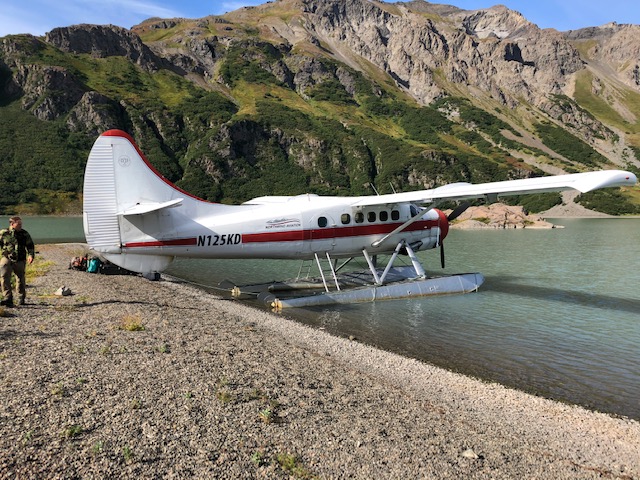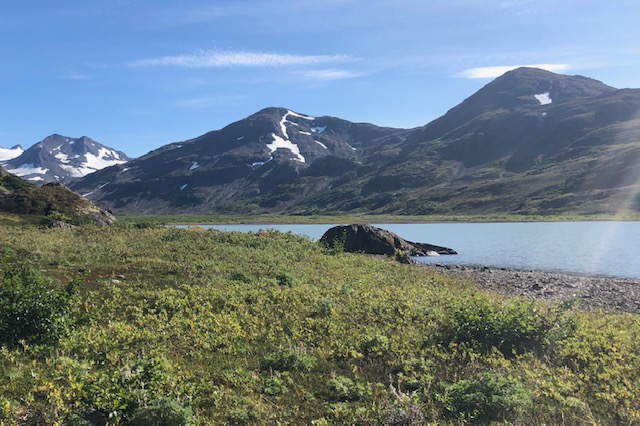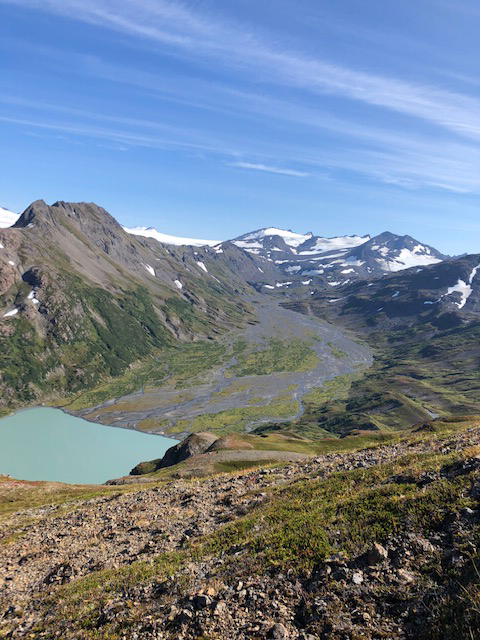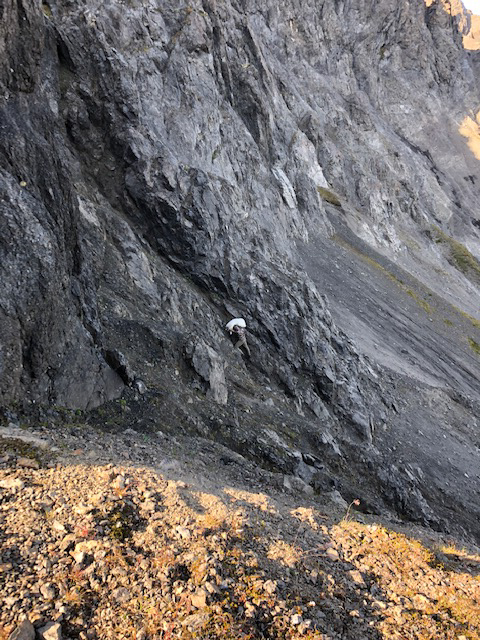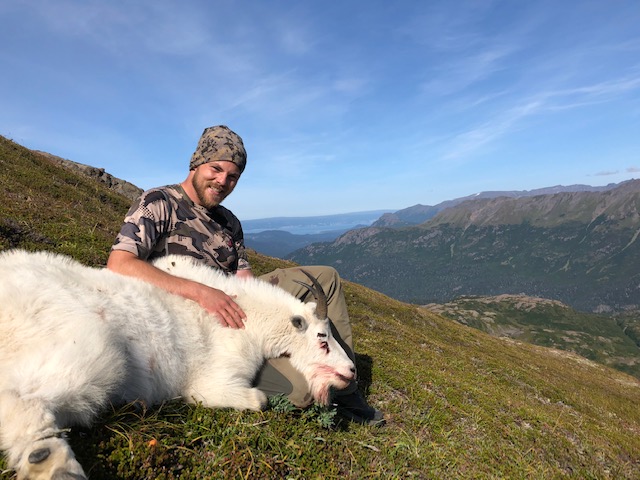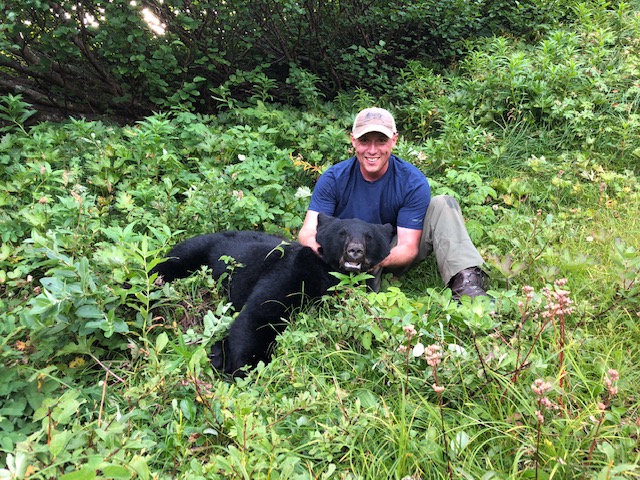As my truck came to rest in front of the small log cabin on a brilliant blue-sky day in early September, it was almost impossible to not be grinning ear to ear. This was the second trip of the fall season I had done with Nate and it was already off to an amazing start. Not many times do you begin a backcountry hunt in what amounts to swimwear — crocs and shorts. With temperatures in the high 60’s and not a cloud in the sky, it was hard to imagine we wear flying out for a mountain goat hunt and not a rendezvous with beachside R&R.
The fall of 2018 didn’t start off quite as leisurely — our Dall sheep hunt haphazardly morphed into hunting two different ranges, 800 miles of driving, with no rams taken, and the final nail in a failed early season hunt. We spent three days atop a high mountain pass, in snow, wind and rain, praying for the weather to pass. Overall, the inaugural trip was demoralizing.
Considering how the prior hunt ended, this hunt was already shaping up to be better. If only for the fact that we were now more concerned with avoiding sunburn rather than keeping the tent from blowing away, spirits were high.
We quickly loaded our Cessna 206 that was moored alongside a glass-like lake in the fishing town of Homer, and within minutes we were high above Kachemak Bay headed south. Our flight was short in time, but with views that make you awestruck by the beauty, I could have spent all week circling the bay.
As I sat in the back, trying to make the shutter on my camera smoke, I heard the dampening of the engine as we prepared for the final approach. Then came the transition from air to water, we had landed and the work was to begin.
The common misconception about hunting in Alaska is that when you are in the backcountry you will be alone, unfettered and isolated. However, we were dropped off on the front stoop of another parties camp. Chair, cooler and a poorly covered stack of firewood were our welcoming sights, luckily it was a ghost town. Prior to the pilot pulling up his hip boots and shoving off into the turquoise chop, he pointed to a prominent peak beside the lake and said: “ you’ll see goats up there…you’ll never get to them though… see ya next week.” My partner, who was the owner of the goat tag, shot me a sideways glance, which I returned with a sly grin, and we knew we’d have to prove our pilot wrong.
We couldn’t hunt that first afternoon due to regulations, but we had goats to find and ground to cover. Packs were quickly organized, crocs swapped for boots, and a heading set for the glacier at the head of the valley. The first day of our hunt couldn’t have started any better, we found several billies in the distance and the evening weather was clear and cold. A certain sense of tranquillity lingering in the air.
Like most mornings in the mountains, the alarm seems to come too quickly, but with thoughts of billies in sight of the camp, the move from sleeping bag to boots was hasty. The plan that we laid out over the previous night’s dinner was to head further up the valley, with hopes of finding an old, crag-loving billy. Camp was packed with a sense of urgency, for no other reason than we wanted to get behind the glass. A short mile or so up the drainage revealed a bench, which was to be a well-placed anchor to glass the end of the permit area, the glacier and a lone pinnacle of rock severing the glacier, and housing a billy.
We sat and glassed over coffee and chow, hashing out how we could close the gap between ourselves and our quarry. It seemed that 100 different plans were discussed but none of them placed the billy into a more accessible location. Unless this billy grew an adventurous spirit, we figured he wouldn’t budge from his spire in the sky. With abundant feed, protection and what I can only assume is a million dollar view, he was not likely to trot our way.
As we took a break from the strain of magnified staring, I took a few moments to stretch and take in the brilliant views of mountains placed below bluebird skies. I snapped a few photos and begin to organize my chaotic pile of disrobed gear. After double checking that I hadn’t lost anything, I sat down with my back to the glacier. Even though I just spent five minutes taking in the view and grabbing some photos, I noticed a new speck on a distant mountain back towards the lake.
After a quick assessment with the spotting scope, Nate says “ We have three goats towards the summit.” As quickly as those words are spoken, the excitement and motivation became palpable. We sat in silence for several minutes, each playing out in our minds how we would get within range of the goats. I asked Nate “Isn’t that the mountain our pilot said we would see goats on?” “Yep” came the reply. “Didn’t he say to not even try?” “Yep” with a stoic cadence. We sat in silence and then Nate spoke those words that marked the beginning of the fun… “Lets Get’em!”
The few miles to the base of the mountain holding the billies were covered quickly thanks to the glacier cut valley floor. But quickly we found our leisurely stroll being turned into an all-hands crawl up the backside of the mountain. Our pilot made mention that everyone that goes up this mountain in hopes of these “untouchable” goats, uses the massive avalanche chutes that face the lake. These chutes feed directly into the feeding and bedding areas atop the mountain, but they also provide no cover and place you directly underneath the goats. This path seems to be the only option when sitting beside the lake, however, we had a different perspective.
Luckily, we spent the first day towards the head of the valley and at a decent altitude, where we could see that there was a steep but navigable path up and behind this group of goats. From afar this path seemed to make for an easy hop, skip and jump stalk, but as we scratched and clawed our way higher, easy was not the case.
After a 2000 foot climb and a lunch break, we began to think that we must be getting close to this group of hopeful billies. Being that both male and female mountain goats grow horns, our distance from the initial spotting was inconclusive to revealing the sex. After such an arduous climb, the thought of a disappointing gender reveal was sure to lower morale.
As we continued to pound our way towards the summit, I instinctively followed my partner in the lead as he threw himself into the hillside behind a large rock outcropping. As I stared forward waiting for a reason for the sudden halt, Nate silently lipped and pointed “GOATS!”
A quick shedding of the pack and a careful glance around the monolith, Nate confirmed three billies, 100 yards and was no sooner shouldering his rifle. The transition from hiking to shooting happened so fast, I didn’t even get eyes on the billy before the shot rang out. Shot one was quickly followed by the rechambering of a second and a sight that knots your gut. The billy was leaping over the ridgeline towards the express route down the cliff face.
We covered the 100 yards to the ridge in what seemed like one giant leap and were given a view of mountains and alpine lakes, without sight of our surely hit goat. I went left and Nate went right, after several minutes of searching we met back up just in time to here the scrawling and scratching of rocks to our right. With the sound came the sight of our limping billy. Nate drew a bead, fired and missed. The billy was still moving but slower. Nate threw the bolt back, dropped in a new round and with this final shot and thud of impact, our last view was airborne hooves heading down a steep cliff.
We both knew that the third shot was surely fatal, but what would be left of our billy after a long tumble down the craggy chute was unknown. There is a certain sense of sickness that falls upon you when you shoot an animal that you can’t find or fear will be pulverized upon finding. The joy of a successful hunt can quickly be turned into a feeling of failure and disrespect to the animal.
We searched, we crawled and choose some sketchy paths, but after an hour of searching, we found the billy, dead and suspended on the last scrap of rock before the unobstructed ride all the way to the lake. With one giant sigh of relief, we gladly welcomed the beginning of the real work. But first how to get the billy off his perch and onto safe ground?
With the help of 50 feet of paracord and my best rope rigging skills, we were able to “goat rope,” lasso and hoist our billy off his perch, across a small chasm of shale and lift him onto a high alpine pasture for butchering.
Sharp knives working in tandem quickly left only a pile of entrails and hooves. With heavy packs and high spirits, our descent to fresh fire-roasted meat was mere minutes away. I was in the lead and with the gut pile still in sight, we were given an 800-yard view to a feeding black bear in the valley below. No sooner was I now on the stalk, rifle in hand, finding a concealed path to harvest our second animal of the day.
As if this black bear was a gift, everything lined up perfectly. With the wind in my face and a creek bottom leading me to within 160 yards, unnoticed, the knives were quickly unpacked and put to work.
We stayed up late that night enjoying a few congratulatory libations, with what is our most successful hunt yet. Nate and I have fought tooth and nail all across our home state of Alaska, learning and failing a lot. But this hunt gave us the assurance that we are doing things right, have paid our dues and that sometimes you just get lucky.
We slept in, loaded up and then had a slow hike back to the lake. We ran into the residents of the camp beside the lake, shared stories and pointed them in the direction of the goat on the glacier. As we sat alongside the water, waiting for our ride home, I leaned over and asked Nate while pointing at the prominent peak beside the lake “Can’t get to them, eh?”


